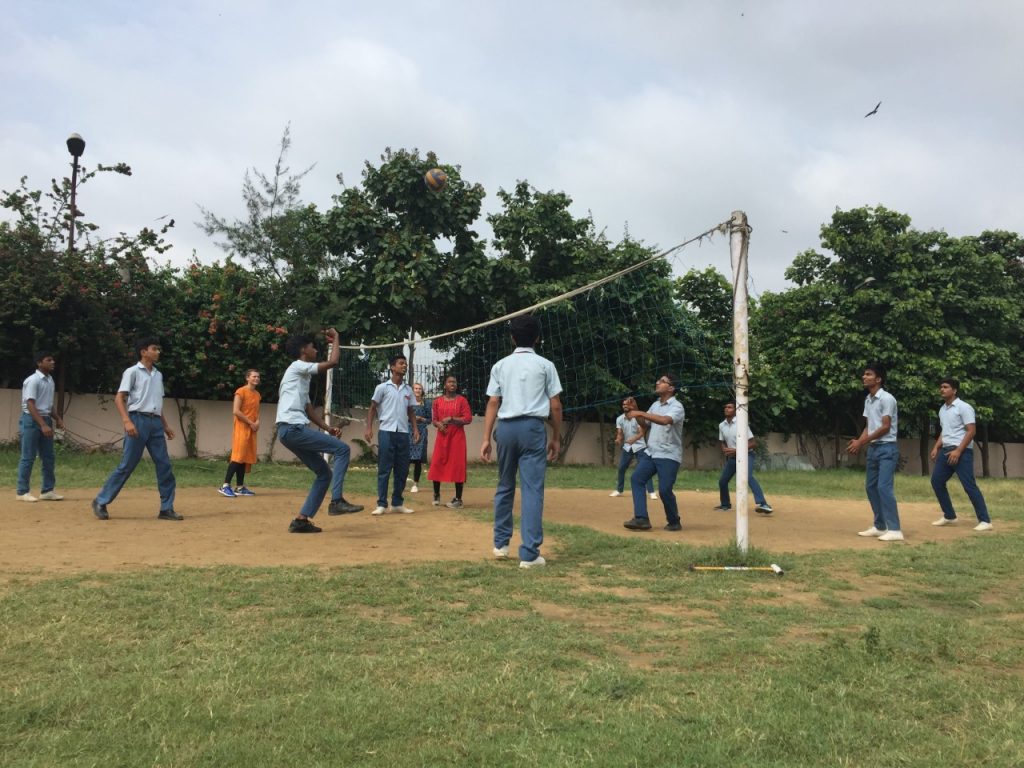
1. How does Vidya School compare to your expectations prior to the trip?
Verity: Vidya School is an amazing place that has exceeded my expectations in a number of ways. I could tell from the moment I got to the school that the students love being there and have a passion and appreciation for learning. From the expansive playing grounds (that are equipped with volleyball and basketball courts, a playground, and more) to the open concept hallways and provided hot lunch, the school has created a happy, safe, and encouraging environment for its students to learn and grow.
Rodney: I expected for the students to be excited and welcoming but for some of the teachers to be less enthusiastic about our arrival. I was right about the students. They enjoy every second that we spend with them, either in the classroom or on the playground. They are interested in large aspects of our lives, like our family, homes, and hobbies, as well as our different mannerisms and gestures. To my surprise, basically all of the teachers have been welcoming. They enjoy watching us teach. Some even take notes and ask questions about our lessons so that they can implement different methods in the future.
2. What have been the biggest challenges in teaching?
Verity: One of the biggest challenges in teaching has been the language barrier between our volunteers and the students. The vast majority of the students speak Hindi as their native tongue, and despite our best efforts at learning some phrases, we are unable to understand most of the communication that goes on outside of English. Given this limitation, we have been able to get creative with vocabulary and grammar games that have allowed us to bridge some gaps that we’ve encountered. I have really enjoyed some of these improvised activities, as I feel the kids gain a better understanding of English and we gain a better understanding of teaching.
Rodney: One challenge in teaching is creating lessons that will cater to the entire class. In all of my classes, students are at different levels. Some students participate regularly, speak and write well in English, and can quickly grasp information. Others struggle with English and don’t participate at all during class. As a teacher, you don’t want to make the material too easy for some students but at the same time, you don’t want to leave other students behind.
3. What are your thoughts on the Indian original game Kabaddi?
Verity: I had seen videos of competitive Kabaddi online before coming to India and was very intrigued, so I was beyond excited when the students at school taught me how to play. Since I learned in my first week at school, I have played Kabaddi every day and have thoroughly enjoyed it. Though the rules of the game are reasonably simple, it’s amazing how intense and thrilling it gets. I feel especially happy to understand and play a game that I know I would not have experienced had I not had the opportunity to come to India.
Rodney: Kabaddi was so confusing when I first saw the kids playing it. It looks like random movements and tackling. The game is actually very fun though. The kids are so physical. Even the girls land solid tackles when they play. Even though I’m much bigger and taller than the kids, I have to be on my A game. Every kid wants to be the one to say that they knocked Rodney down.
4. How have your comfort levels in the community changed since your arrival here?
Verity: My comfort levels have noticeably increased the longer I have been in Delhi. I realized over the past week that the aspects of this new country that initially seemed daunting to me are things that I do not think twice about now. I have learned how to cross traffic, to tune out the many car horns that blast on the streets, and to roughly convert rupees to dollars in my head. I also feel much more comfortable interacting with locals here despite not necessarily speaking the same language. I am pleased to feel an increased comfort in my host environment because I know it is a result of how much I have learned in the past few weeks.
Rodney: My comfort levels have increased significantly. People in public areas tend to stare very hard. At first, the constant stares can be awkward or make you feel uncomfortable, especially due to the fact that there are countless people nearly everywhere you go. This is just the way the people are. Staring is considered rude in the U.S. but it’s a norm here in India. Eventually, the stares just become a way of life.
